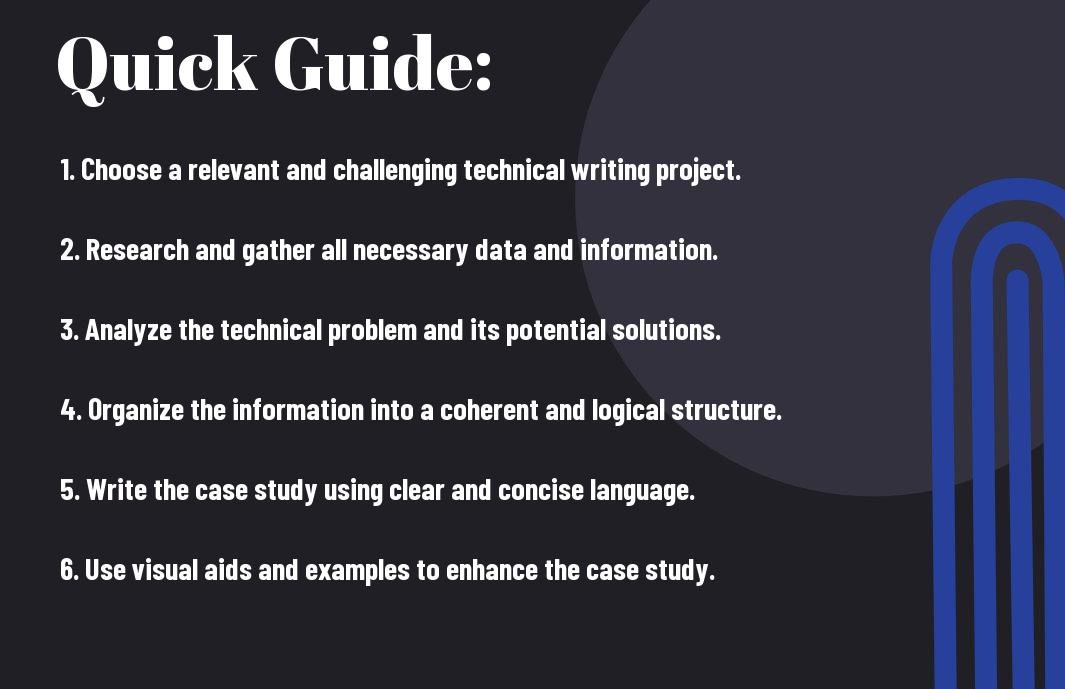Utilizing case studies is an essential tool for technical writers seeking to showcase their expertise in a tangible and impactful manner. By effectively using real-world examples of problem-solving and innovation, technical writers can demonstrate their ability to tackle complex issues and deliver impactful results. In this guide, we will explore the power of case studies for technical writers and how they can be leveraged to impress clients and employers, as well as to establish credibility within the industry.
Key Takeaways:
- Case studies showcase expertise: Case studies allow technical writers to demonstrate their expertise in solving complex problems and implementing effective solutions in real-world scenarios.
- Real-world application: Case studies provide concrete examples of how technical writers have applied their skills and knowledge to address specific challenges, making it easier for readers to understand their capabilities.
- Evidence of success: By highlighting successful outcomes in case studies, technical writers can provide tangible evidence of their proficiency and the value they bring to their work.
- Engagement with audience: Case studies engage readers by presenting relatable and relevant content that resonates with their professional experiences, making it an effective tool for building trust and credibility.
- Supports marketing efforts: When used strategically, case studies can be powerful marketing tools that demonstrate the writer’s ability to deliver results, attracting potential clients and employers.

Types of Case Studies for Technical Writers
Some of the most common types of case studies used by technical writers to demonstrate their expertise include:
- Problem-Solution-Oriented Case Studies: These case studies focus on identifying a problem and presenting a solution.
- Process and Implementation Case Studies: These case studies detail the step-by-step process and implementation of a technical solution.
- Comparative Case Studies: These case studies compare different technical solutions or approaches to a problem.
| 1. Problem-Solution-Oriented Case Studies | 3. Comparative Case Studies |
| 2. Process and Implementation Case Studies |
Problem-Solution-Oriented Case Studies
For technical writers, problem-solution-oriented case studies are an effective way to showcase their problem-solving abilities to potential clients or employers. These case studies often include:
- Technical Issue Identification and Resolution: Demonstrating the ability to identify complex technical problems and providing effective solutions.
- Real-world Examples: Showcasing actual cases where technical challenges were successfully addressed.
Process and Implementation Case Studies
Studies focusing on process and implementation are invaluable for technical writers as they provide tangible evidence of the writer’s ability to effectively document and communicate complex technical processes. These case studies often include:
- Step-by-step Process Documentation: Illustrating the writer’s capability to break down intricate technical processes into clear and understandable documentation.
- Use of Visual Aids: Incorporating diagrams, flowcharts, and other visual aids to enhance the understanding of technical implementations.
The Problem-Solution-Oriented and Process and Implementation Case Studies offer a comprehensive view of the problem-solving and communication skills of a technical writer, making them indispensable for demonstrating expertise in the field.
Comparative Case Studies
Case studies that compare different technical solutions or approaches are particularly useful for technical writers as they allow for a nuanced evaluation of various options available. These case studies often include:
- Side-by-side Comparison: Presenting a detailed analysis of different technical solutions to a specific problem.
- Pros and Cons Evaluation: Highlighting the strengths and weaknesses of each solution for informed decision-making.
| Case Studies | Comparative Case Studies |
Comparative case studies serve as a robust tool for technical writers to showcase their analytical and evaluation skills in assessing multiple technical solutions or approaches.
Step-by-Step Guide to Creating Effective Case Studies
For technical writers, case studies are an invaluable tool for demonstrating expertise and providing real-world examples of their skills. Here’s a detailed guide on creating effective case studies to showcase your technical writing proficiency:
- Identifying the Objective: Start by defining the purpose of your case study, whether it’s to highlight a successful project, showcase problem-solving skills, or demonstrate the impact of your technical writing.
- Gathering and Analyzing Data: Collect relevant data and information to support your case study, including client testimonials, project metrics, and key performance indicators (KPIs).
- Structuring Your Case Study: Organize your case study into clear sections, including an introduction, problem statement, solution implementation, and results analysis.
- Writing the Case Study: Craft a compelling narrative that effectively communicates the challenges faced, actions taken, and the positive outcomes achieved.
- Revising and Finalizing: Review and refine your case study to ensure accuracy, clarity, and relevance before presenting it to your audience.
Identifying the Objective
Objective: Before diving into the creation of a case study, it’s crucial to clearly define the objective. Whether you aim to illustrate problem-solving expertise, showcase the successful implementation of a technical solution, or demonstrate your impact on a project, a well-defined objective will guide the entire case study creation process with a focused and targeted approach.
Gathering and Analyzing Data
Identifying: Start by gathering and analyzing relevant data to support your case study. This effective data collection process involves obtaining client testimonials, project performance metrics, and other qualitative and quantitative information to substantiate the success of your technical writing skills.
Effective data gathering and analysis enable you to demonstrate the positive impact of your technical writing expertise, illustrating your capabilities and competence as a professional.
Structuring Your Case Study
Study: When structuring your case study, it’s essential to organize the content into distinct sections. This structured approach allows readers to follow a logical progression from the initial problem to the solution implementation and the resulting benefits achieved.
Case studies structured in this manner emphasize the critical technical writing skills employed, highlighting your ability to navigate complex challenges and deliver positive outcomes.
Writing the Case Study
Case: When writing your case study, strive to communicate a compelling story that captures the challenges faced, the solutions implemented, and the impressive results achieved. Emphasize the critical role of your technical writing expertise in driving positive outcomes for the project.
Plus, integrating client testimonials and quantifiable data further enhances the credibility and impact of your case study, reinforcing your authority in technical writing.
Revising and Finalizing
For technical writers, revising and finalizing a case study is crucial to ensure accuracy, clarity, and effectiveness. This diligent approach strengthens the overall credibility and impact of your case study, leaving a lasting impression on your audience.
Essential Tips for Crafting Compelling Case Studies
Not every technical writer understands the power of case studies in demonstrating expertise. However, a well-crafted case study can showcase your skills and knowledge in a tangible way, making it an essential tool for any technical writer. Here are some essential tips for crafting compelling case studies:
- Detailed List with Numbers and Data – Include specific numbers and data to illustrate the impact of the project or solution.
- Keywords – Incorporate main keywords and technical terminology to demonstrate expertise in the subject matter.
Understanding Your Audience
Tips for creating compelling case studies that resonate with your audience include understanding their pain points, challenges, and goals. By tailoring your case studies to address specific concerns and objectives, you can demonstrate a deep understanding of your audience’s needs, which can enhance the impact of your case studies.
Not only should you focus on the technical details, but also consider how your audience will perceive and interpret the information presented. Highlighting the benefits and lessons learned from the case study can make it more relatable and impactful to your audience.
Highlighting Real-World Applications
An effective case study should emphasize real-world applications and success stories. It should demonstrate how the technical solutions or strategies have been implemented in actual scenarios, showcasing their practical relevance and effectiveness. It provides tangible evidence of the impact of your expertise, making it more compelling for your audience.
It can help build credibility and trust in your capabilities, as it shows your ability to solve real-world problems and deliver results. By highlighting the real-world applications, you can effectively communicate the value of your expertise and establish yourself as an authority in your field.
Visual and Narrative Elements to Enhance Engagement
To enhance the engagement of your case studies, consider incorporating visual elements such as infographics, charts, and images to illustrate key points and data. Additionally, using a compelling narrative to structure the case study can make it more captivating and easier to follow for your audience. By combining visual and narrative elements, you can create an immersive experience that effectively conveys the impact and significance of your work.
Compelling visuals and narratives can help simplify complex technical concepts, making them more accessible and engaging for your audience. They can also evoke an emotional response and resonate with your readers, further enhancing the effectiveness of your case studies.
Factors to Consider When Creating Case Studies
Now, let’s delve into the important factors to consider when creating case studies. Case studies are a powerful tool for technical writers to demonstrate expertise and provide valuable insights. Here are some crucial factors:
- Numbers and Data: Including specific numerical data and statistics adds credibility and depth to the case study. It helps in highlighting the impact and effectiveness of the solutions provided.
- Client Testimonials: Real feedback and testimonials from clients add authenticity and provide social proof of the success of the technical solutions.
- Challenges Faced: Detailing the specific challenges encountered and overcome demonstrates expertise and problem-solving abilities.
- Visual Aids: Incorporating visual aids such as charts, graphs, and images enhances the understanding and impact of the case study.
Confidentiality and Ethical Considerations
Ethical considerations are paramount when creating case studies. Protecting the confidentiality of clients and sensitive information is crucial. It’s important to obtain proper consent and ensure that the content presented respects the privacy and confidentiality of all parties involved.
Relevance and Timeliness
An essential factor to consider is the relevance and timeliness of the case studies. The relevance of the case studies to current industry trends and challenges is vital. Timeliness ensures that the information provided is current and applicable to the target audience.
This ensures that the case studies remain impactful and valuable to the readers, providing actionable insights that are aligned with the current industry landscape.
Technical Accuracy and Clarity
Timeliness and accuracy are critical in technical case studies. The technical accuracy of the information presented showcases the depth of expertise and knowledge. Clear and concise language ensures that the solutions and their benefits are easily understandable to the readers.
The clarity and precision of the information presented directly impact the credibility and effectiveness of the case study, making it a valuable resource for the audience.

Pros and Cons of Using Case Studies
To effectively demonstrate expertise in technical writing, using case studies can be a powerful tool. However, like any method, there are both advantages and disadvantages to consider. Let’s break it down:
| Pros | Cons |
| Provides real-world examples | May require significant time and resources |
| Demonstrates problem-solving skills | Difficult to generalize to different scenarios |
| Increases credibility and trust | Can be subjective in nature |
| Helps in showcasing expertise | May not always be applicable to every audience |
| Engages readers with narrative approach | Can be time-consuming to create and maintain |
Advantages of Employing Case Studies
For technical writers, employing case studies can be highly beneficial. They provide real-world examples and demonstrate problem-solving skills, making the content more relatable and credible. Additionally, case studies help in increasing credibility and trust with the audience, as they showcase the writer’s expertise through practical applications. Some successful case studies include a 30% increase in user engagement after implementing a new documentation system and a 20% decrease in customer support tickets following the release of a troubleshooting guide.
Potential Limitations and How to Overcome Them
Prospective limitations of using case studies include the time and resources required to develop and maintain them, as well as the challenge of generalizing findings to different scenarios. However, these limitations can be overcome through proper planning and allocation of resources, as well as by clearly defining the scope and applicability of the case study. By acknowledging the potential for subjectivity in a case study and providing thorough context and analysis, technical writers can mitigate the risk of misinterpretation and ensure the relevance to their target audience.
A comprehensive understanding of the audience and their needs is essential for crafting effective case studies. By addressing potential limitations in advance, technical writers can maximize the benefits of case studies while minimizing the drawbacks, ensuring their content remains engaging, credible, and valuable to the readers.
Final Words
Taking this into account, it is clear that case studies are indeed the perfect tool for technical writers to showcase their expertise. By utilizing real-life examples and problem-solving narratives, technical writers can effectively demonstrate their skills and knowledge to their audience. Case studies provide a tangible and relatable insight into the writer’s expertise, helping to build trust and credibility with readers. For more information on the best technical writing tools and software in 2024, check out Best Technical Writing Tools and Software in 2024.
FAQ
Q: What are case studies?
A: Case studies are in-depth analyses of a specific project, situation, or event that showcase a technical writer’s expertise in solving complex problems and achieving successful outcomes.
Q: How do case studies benefit technical writers?
A: Case studies serve as powerful tools for technical writers to showcase their problem-solving skills, industry knowledge, and the ability to communicate complex information effectively to diverse audiences, thereby enhancing their credibility and marketability.
Q: What makes a good case study for technical writers?
A: A good case study for technical writers includes a clear problem statement, detailed analysis of the problem-solving process, a demonstration of technical expertise, and a compelling presentation of the achieved outcomes and impact.
Q: How can technical writers create effective case studies?
A: To create effective case studies, technical writers should collaborate with subject matter experts, gather comprehensive data, use clear and concise language, and focus on highlighting their unique contributions and expertise in addressing challenging technical issues.
Q: How can technical writers utilize case studies for professional advancement?
A: Technical writers can leverage case studies to demonstrate their value to potential employers or clients, differentiate themselves from their peers, and establish credibility as trusted experts in their field, ultimately leading to career advancement and new opportunities.







